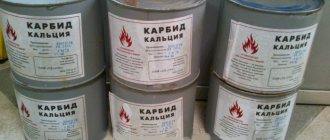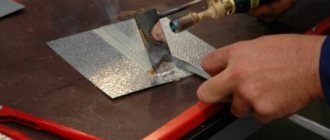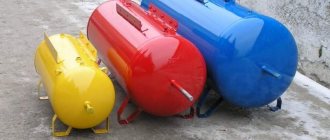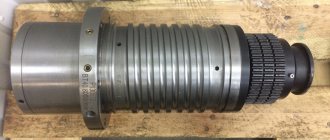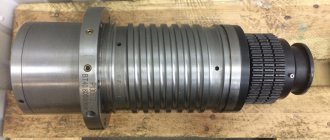Welding carbide or full name calcium carbide is the main substance for producing acetylene gas. In fact, it is an active chemical compound of calcium and carbon and, when finished, is a solid composition with a dark gray or brown tint. The smell of carbide resembles the pungent smell of garlic and reacts with water to release heat.
Calcium carbide is an ideal substance for welding, since upon contact with water it releases acetylene, a volatile gas that is the basis for oxygen welding, soldering, metallization and other processes associated with metal processing. Calcium carbide is created at temperatures up to 2300 degrees Celsius by fusing coke and quicklime in an electric arc furnace (Figure 1). After this, the molten substance is poured onto molds, and in them it cools and takes on a solid state. After this, the carbide for welding is crushed into pieces, the size of which does not exceed 8 cm. As a result, the substance will consist of 75 percent calcium carbide, and the rest - impurities, lime oxide, etc.
Physical properties
When choosing almost any material, you should pay most attention to physical properties. For the one under consideration they are as follows:
- The compound has a crystalline structure.
- The melting point is 2300 °C. It is worth considering that such a figure is characteristic only of the pure composition. The addition of various impurities to the composition causes the melting point to drop significantly.
Pure Calcium Carbide
It is worth considering that calcium carbide in most cases is in a solid state. In addition, the color can vary from gray to brown. The physical properties of calcium carbide determine its widespread use in a wide variety of industries.
Receipt
The production of calcium carbide is as follows. Quicklime and pre-crushed coke are mixed. The resulting mixture is melted in electric furnaces. Coke and calcium oxide are taken in equal parts by weight. The process occurs at a temperature of 1900 oC. The melt leaves the furnace and is subsequently poured into special molds. Then the already hardened calcium carbide is crushed and sorted by size of the pieces. Granules of the substance are divided into four fractions in accordance with their sizes: 25×80, 15×25, 8×15, 2×8, which are determined by GOST 1460-56. In its composition, technical calcium carbide contains 75-80% of the main substance. The share of impurities, such as carbon, lime and others, accounts for up to 25% of the total mass of the resulting mixture. In addition, the calcium sulfide and calcium phosphide contained in technical carbide cause a rather unpleasant odor. Let's imagine the reaction for producing CaC2: CaO + 3C → CaC2 + CO↑. The formation of calcium acetylide is accompanied by the absorption of heat. Therefore, it is logical to assume that the reaction of its decomposition, on the contrary, occurs with the release of energy.
Read also: Random selection from the Randomus list
Production method
Carbide is produced in electric furnaces by fusing (calcining) a mixture of coke and calcium oxide (quicklime) at temperatures ranging from 1900°C to 2300°C. The sharp and unpleasant garlic smell of carbide and the produced acetylene is caused by the content of impurities of calcium phosphides and sulfates in the carbide mixture.
The process is carried out in several stages:
- Limestone is fired.
- A powder mixture is created from processed lime and coke - a mixture.
- The resulting mixture is calcined in an electric arc furnace until it melts.
- The resulting carbide bars are crushed to obtain the desired fraction.
The average density of the carbide substance is 2.2 g/cm3. Depending on the impurity content, the color of carbide can be dark brown or dark gray.
The final product consists of 75-78% CaC2, the rest being lime and impurities. Carbide granules come in different sizes: 2x8; 8x15; 15×25; 25x80 mm. Larger granules produce more acetylene but increase reaction time. If granules of 8x15 and 15x25 mm decompose in 5-6 minutes, then granules of 25x80 mm require more than 10 minutes to decompose.
Safety precautions
When carrying out various chemical reactions to produce materials, safety precautions must be observed. As previously noted, the released substances can be explosive. Safety precautions when interacting with various chemicals are as follows:
- An airtight place is required for storage and handling. It is not recommended to carry out work in a regular garage.
- Fire should not be allowed to reach the raw material itself, as well as the gases generated.
- Even small particles can damage the skin. That is why work must be carried out in a respirator and protective clothing.
- Acetylene generators are placed exclusively in well-insulated rooms.
- If the raw materials were used during welding work, then the resulting slag should be disposed of in special places.
- When moving metal and other containers, they must be securely fastened; collisions and falls are not allowed. This may result in sparks that could cause the substance to explode.
Calcium carbide combustion
The above information determines that work with the raw materials in question is not recommended to be carried out in a garage or home workshop. Failure to comply with technology, lack of required equipment and many other reasons can lead to sparks and ignition of substances.
Calcium carbide in welding
For welding work, carbide is almost an ideal substance, because when it interacts with water, it releases volatile acetylene gas into the surrounding space, which serves as the basis for metallization, soldering, oxygen welding and many other processes related to the processing of metal alloys.
This composition is created at very high temperatures (up to 2400 degrees) by melting quicklime and coke inside an electric arc furnace. Then the hot liquid substance is placed in special molds (molds), where it freezes and hardens. Then the carbide is split into pieces no larger than 8 cm in size. As a result, the resulting substance will consist of approximately 78% calcium carbide, and the remaining 22% is lime oxides, impurities and other substances.
Welding applications
Carbide is stored in special steel tanks with a volume of 100 or 130 liters. These tanks should only be opened when there is no fire or sparks in the vicinity using a wooden hammer and a brass chisel. Unused carbide in the jar is sealed with a waterproof lid.
Acetylene for welding is produced from carbide in a generator of stationary or mobile type and of different volumes. The average volume of acetylene generators is designed to receive from 5 to 15 liters of water and, accordingly, 2-5 kilograms of carbide. The yield of acetylene is considered slightly lower than theoretical and is taken to be 260-280 liters per kilogram of CaC2. It is recommended to use coarse carbide – 80 mm
The principle of using acetylene for welding work is as follows:
- About 250 liters of acetylene are released from one kilogram of carbide, and 3-4 liters of water are required to decompose a kilogram of carbide. Knowing these proportions, the required volume of water and the amount of substance are calculated.
- In industrial generators, designed for a long and uniform process of use, carbide is dosed into the gas-forming chamber through a special hopper in automatic mode. In generators that are used for non-standardized volumes of work, the carbide is immersed in water in a special basket. The volume of acetylene produced is regulated by immersing or raising the basket.
- When the next portion of carbide is supplied and the reaction begins, the pressure in the chamber increases, which is reduced by the active release of acetylene into the burner.
- Acetylene is fed through a hose into the gas burner. The burner must be located at least 10 meters from the generator.
- The slaked lime formed during the reaction (about 1.2 kg per kilogram of carbide) is removed from the generator through a separate hopper.
In gas welding, the main advantage of using carbide is its low weight and the light weight of the equipment used. Gas cylinders for acetylene are very heavy; they must be moved on a special trolley or with 2-3 pairs of hands. The average generator weighs 15-20 kg, which allows you to move it without much effort alone or with one assistant. When moving dry carbide, it is enough to follow basic storage rules - avoid getting moisture on the substance and getting fine carbide dust on your skin and eyes.
Features of application
This substance is used everywhere in welding. This is done according to the following scheme:
- The carbide pieces are placed in a basket. The optimal size of the elements is 8 cm. Such “pebbles” can ensure optimal production of acetylene gas. Experts do not recommend pouring carbide dust into the generator. Particles less than 2 mm in diameter release acetylene almost instantly, which can lead to equipment explosion.
- The basket is placed in a special tank with water. Its neck must be closed with a tight lid with a screw fastening.
- By rotating the screw flywheel, the basket with pieces of the substance is immersed in water, and the generation of acetylene gas begins. By decreasing/increasing the immersion depth of the basket, you can regulate the intensity of acetylene production, maintaining optimal intensity in the welding device’s burner.
During welding operations, carbide acts as a fuel that saturates the gas generator. And without its use it will be difficult to use an acetylene torch. After all, a gas cylinder is very difficult to move. And the carbide pieces just need to be placed in a sealed container and transported to absolutely any distance, preventing the appearance of moisture.
What types of carbides are there?
It turns out that carbide, the formula of which is, say, CaC2, differs significantly in structure from SiC. And the difference is primarily in the nature of the connection between atoms. In the first case, we are dealing with salt-like carbide. This class of compounds is named so because it actually behaves like a salt, that is, it is capable of dissociating into ions. This ionic bond is very weak, which makes it easy to carry out the hydrolysis reaction and many other transformations involving interactions between ions.
Another, probably more industrially important type of carbides are covalent carbides: such as, for example, SiC or WC. They are characterized by high density and strength. They are also refractory and inert to diluted chemicals.
There are also metal-like carbides. They can rather be considered as alloys of metals with carbon. Among these we can highlight, for example, cementite (iron carbide, the formula of which varies, but on average it is something like this: Fe3C) or cast iron. They have a chemical activity intermediate in degree between ionic and covalent carbides.
Each of these subtypes of the class of chemical compounds we are discussing has its own practical application. We will talk about how and where each of them is used in the next section.
What is needed for acetylene welding?
Gas welding requires two types of gases, the first is oxygen and the second is acetylene. The oxygen compound is necessary to promote the combustion of acetylene during welding and other types of work. Acetylene itself is a flammable substance.
Interesting materials:
Which is correct: silicone or silicone? How to properly attach a plinth to the floor? Which is correct: Christina or Christina? How to cut velvet with or against the pile? How to eat artichoke correctly? Which is correct: lemon or lemon? Which is correct: Lithuania or Republic of Lithuania? How to properly catch catfish on the river? How to properly marinate meat for cold smoking? How does it interfere?
Properties and composition
To obtain this stone, you need at least two elements. First is carbon. Its presence is mandatory. And then there is a choice: metal or non-metal. The main thing is that the rule is followed: the electronegativity (the force with which the atoms of an element attract foreign electrons) of the required component is higher than that of its “partner”. Otherwise you will get completely different connections.
Calcium Carbide Formula
This connection was first discussed in England back in the 19th century. However, the fame of the discoverer went to the Frenchman, thanks to whose experiments the substance was officially recognized; this happened only towards the end of the century. And now about what qualities are inherent in this compound:
- The material is unusually hard. According to this indicator, it almost caught up with diamond. Among the record holders is tungsten carbide (9 out of 10 possible points). This opens up hundreds of ways to use it.
- It will take a lot of effort to melt the stone. After all, for this it is necessary to heat it to 2, or even 3 thousand degrees Celsius. This figure will be higher than the values necessary to change the state of metallic substances before they were included in the carbide.
- This is a very “non-contact” connection. Thus, the reaction of carbide to many substances will be zero. This requires special conditions. Therefore, they are not afraid of acids and other substances that promote corrosion.
- But the previous point does not apply to water. As you already understood from the story above, carbide and water often go hand in hand. In the case, for example, when calcium carbide , absolutely any moisture is suitable for this, no conventions are needed. If the work is silicon carbide , then there is no way without heating - you need hot steam (1800 degrees).
Properties
Due to their properties, these compounds are widely used in mechanical engineering , as well as in construction.
- High hardness of the material. It varies for different compounds, but always remains above average. They are the hardest minerals.
- Melting temperature . Almost always it is higher than the melting point of the metal included in the connection and can exceed 2000 degrees.
- Corrosion resistance. Many compounds do not react with various acids and are quite resistant to external aggressive factors.
- Interaction with water. Almost all carbide compounds react with water; for example, when interacting with calcium carbide, it can explode. The terms of interaction may vary and depend on the nature of the connection in the connection.
Content:
Welding carbide or full name calcium carbide is the main substance for producing acetylene gas.
In fact, it is an active chemical compound of calcium and carbon and, when finished, is a solid composition with a dark gray or brown tint. The smell of carbide resembles the pungent smell of garlic and reacts with water to release heat. Calcium carbide is an ideal substance for welding, since upon contact with water it releases acetylene, a volatile gas that is the basis for oxygen welding, soldering, metallization and other processes associated with metal processing. Calcium carbide is created at temperatures up to 2300 degrees Celsius by fusing coke and quicklime in an electric arc furnace (Figure 1). After this, the molten substance is poured onto molds, and in them it cools and takes on a solid state. After this, the carbide for welding is crushed into pieces, the size of which does not exceed 8 cm. As a result, the substance will consist of 75 percent calcium carbide, and the rest - impurities, lime oxide, etc.
Storage and transportation
Since carbide, when reacting with moisture, leads to the release of large amounts of heat and explosive acetylene gas, this substance is stored in sealed tanks or drums. Working with such tanks requires special care. Acetylene gas is lighter than air and is capable of self-ignition, while it has a narcotic effect . When opening drums with carbide, a special tool is used to prevent the occurrence of sparks, and if the substance gets on the skin, you must immediately rinse the affected area with water and lubricate it with a rich cream.
Storage areas must be well ventilated, and keeping other substances in the vicinity is prohibited. This may lead to dangerous reactions. Improper storage can either explode the carbide or render it unusable.
The shelf life is only up to six months.
Transportation is carried out only by covered transport. Air delivery is prohibited.
Calcium carbide as a “fuel” for welding.
As mentioned above, when welding, carbide reacts actively with water, releasing a huge amount of heat and acetylene gas. This feature complicates the storage of carbide, so to preserve it, the substance is placed in sealed roofing steel tanks with a capacity of 100 and 130 kilograms. Since carbide releases highly flammable acetylene, it is vital to avoid sparks or open flames when opening these cans.
Calcium carbide dust - particles up to 2 millimeters - is not suitable for use, since it dissolves almost immediately in water and at the same time, the likelihood increases that the use of such a composition will lead to an explosion of the entire cylinder.
For the curious, one kilogram of calcium carbide, depending on the purity and size of the pieces, upon contact with water can release more than 250 dm 3 of acetylene!
Calcium carbide is actively used during gas welding and cutting. When burned with oxygen, acetylene can reach a highest melting point of up to 3150 degrees Celsius, which makes it indispensable when working with refractory metals, because welding or cutting requires a temperature twice the melting degree of the metal itself.
For safe use, acetylene is produced in special generators (Fig. 2) based on calcium carbide or natural gas, oil and coal.
The second method of producing acetylene from natural gas, oil and coal is cheaper than using calcium carbide, by about 30 - 40%.
Safety requirements
Due to the fact that this is a hazardous material, it is necessary to work with it strictly following safety rules. Basic rules that must be followed when welding with carbide:
- Do not forget that carbide reacts very actively to exposure to water and air.
- The substance must be stored exclusively in a sealed and dry place.
- The substance is very explosive, therefore open flames and sparks near it are strictly prohibited.
- Carbide dust can cause irritation of mucous membranes and skin, so when working with it you must use safety glasses, gloves and a respirator.
- Installation of acetylene generators is prohibited in basements.
- After finishing welding using carbide pieces, you need to “modify” the remaining substance into generators. The resulting slags should be placed in a special bunker or pit.
- Smoking is also prohibited when working with this material.
- Points and impacts when transporting gas cylinders are extremely dangerous and can lead to tragic consequences.
By following these guidelines, you can safely use carbide for welding. In addition, this substance allows you to save and reduce acetylene consumption.
How to obtain carbon dioxide from acetylene?
When acetylene burns, carbon dioxide and water are formed. 2CH ≡ CH + 5O2 → 4CO2 + 2H2O Let’s place the test tube into the flame of burning acetylene. Soot settles on the test tube. With a lack of oxygen, acetylene does not have time to burn completely and releases carbon in the form of soot.
Interesting materials:
How to view disappearing messages on Instagram? How to view SMS history on MTS? How to view history in Google Chrome browser? How can I see my accumulated VTB miles? How can I view canceled flights? How can I view ownership? How to view your Gmail profile? How can I view past declarations? How to watch stories on YouTube? How to see hidden friends?
